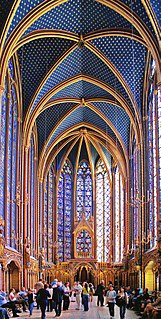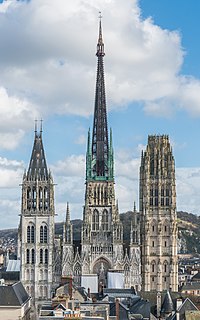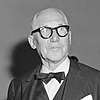
Charles-Édouard Jeanneret, known as Le Corbusier, was a Swiss-French architect, designer, painter, urban planner, writer, and one of the pioneers of what is now regarded as modern architecture. He was born in Switzerland and became a French citizen in 1930. His career spanned five decades, and he designed buildings in Europe, Japan, India, and North and South America.

The Sainte-Chapelle is a royal chapel in the Gothic style, within the medieval Palais de la Cité, the residence of the Kings of France until the 14th century, on the Île de la Cité in the River Seine in Paris, France.

Chartres Cathedral, also known as the Cathedral of Our Lady of Chartres, is a Roman Catholic church in Chartres, France, about 80 km southwest of Paris, and is the seat of the Bishop of Chartres. Mostly constructed between 1194 and 1220, it stands at the site of at least five cathedrals that have occupied the site since the Diocese of Chartres was formed as an episcopal see in the 4th century. It is in the High Gothic and Romanesque styles.

Modern architecture, or modernist architecture, was an architectural movement or architectural style based upon new and innovative technologies of construction, particularly the use of glass, steel, and reinforced concrete; the idea that form should follow function (functionalism); an embrace of minimalism; and a rejection of ornament. It emerged in the first half of the 20th century and became dominant after World War II until the 1980s, when it was gradually replaced as the principal style for institutional and corporate buildings by postmodern architecture.
The year 1955 in architecture involved some significant architectural events and new buildings.

Strasbourg Cathedral or the Cathedral of Our Lady of Strasbourg, also known as Strasbourg Minster, is a Catholic cathedral in Strasbourg, Alsace, France. Although considerable parts of it are still in Romanesque architecture, it is widely considered to be among the finest examples of Rayonnant Gothic architecture. Architect Erwin von Steinbach is credited for major contributions from 1277 to his death in 1318, and beyond through his son Johannes von Steinbach, and his grandson Gerlach von Steinbach, who succeeded him as chief architects. The Steinbachs's plans for the completion of the cathedral were not followed through by the chief architects who took over after them, and instead of the originally envisioned two spires, a single, octagonal tower with an elongated, octagonal crowning was built on the northern side of the west facade by master Ulrich von Ensingen and his successor, Johannes Hültz. The construction of the cathedral, which had started in the year 1015 and had been relaunched in 1190, was finished in 1439.

Ronchamp is a commune in the Haute-Saône department in the region of Bourgogne-Franche-Comté in eastern France.

Sainte Marie de La Tourette is a Dominican Order priory, located on a hillside near Lyon, France, designed by the architect Le Corbusier, the architect’s final building. The design of the building began in May 1953 and completed in 1961. The committee that decided the creation of the building considered that the primary duty of the monastery should be the spiritual awakening of the people and in particular the inhabitants of nearby areas. As a result, the monastery was constructed in Eveux-sur-Arbresle, which is just 25 km from Lyon and is accessible by train or car.

Rouen Cathedral is a Roman Catholic church in Rouen, Normandy, France. It is the see of the Archbishop of Rouen, Primate of Normandy. It is famous for its three towers, each in a different style. The cathedral, built and rebuilt over a period of more than eight hundred years, has features from Early Gothic to late Flamboyant and Renaissance architecture. It also has a place in art history as the subject of a series of impressionist paintings by Claude Monet.

Futuna Chapel is a building in Wellington, New Zealand designed by the architect John Scott.

Marie-Alain Couturier, O.P., was a French Dominican friar and Catholic priest, who gained fame as a designer of stained glass windows. He was noted for his modern inspiration in the field of Sacred art.

French architecture consists of numerous architectural styles that either originated in France or elsewhere and were developed within the territories of France.

French Gothic architecture is an architectural style which emerged in France in 1140, and was dominant until the mid-16th century. The most notable examples are the great Gothic cathedrals of France, including Notre-Dame Cathedral, Reims Cathedral, Chartres Cathedral, and Amiens Cathedral. Its main characteristics were the search for verticality, or height, and the innovative use of the rib vault and flying buttresses and other architectural innovations to distribute the weight of the stone structures to supports on the outside, allowing unprecedented height and volume, The new techniques also permitted the addition of larger windows, including enormous stained glass windows, which filled the cathedrals with light. The French style was widely copied in other parts of northern Europe, particularly Germany and England. It was gradually supplanted as the dominant French style in the mid-16th century by French Renaissance architecture.

Évry Cathedral is a Roman Catholic church located in the new town of Évry (Essonne), France. The cathedral was designed by Swiss architect Mario Botta. It opened in 1995 and was consecrated and dedicated to Saint Corbinian in 1996. It is the only cathedral begun and completed in France in the 20th century.

The Musée de l'Œuvre Notre-Dame is the city of Strasbourg's museum for Upper Rhenish fine arts and decorative arts, dating from the early Middle Ages until 1681. The museum is famous for its collection of original sculptures, glass windows, architectural fragments, as well as the building plans of Strasbourg Cathedral. It has a considerable collection of works by Peter Hemmel von Andlau, Niclas Gerhaert van Leyden, Nikolaus Hagenauer, Ivo Strigel, Konrad Witz, Hans Baldung and Sebastian Stoskopff.

Maria, Königin des Friedens is a pilgrimage church and parish in Neviges, part of Velbert, North Rhine-Westphalia, Germany. The pilgrimage dates back to 1676. Neviges was the home of a Franciscan monastery from 1675 until the end of 2019. A church dedicated to the Immaculate Conception in 1728 became too small for the growing numbers of pilgrims in the 20th century.

Notre-Dame-de-la-Salette is a Roman Catholic church located rue de Cronstadt in the 15th arrondissement of Paris. It is under the patronage of Our Lady of La Salette, particularly revered by the religious congregation of St. Vincent de Paul.

All Saints Church, Douglas, Isle of Man, is a 1967 Modernist Anglican church which closed in May 2017.

Wollaston College is an Australian educational institution in Perth, Western Australia, established in 1957. It provides theological education for both lay and ordained people of the Anglican Diocese of Perth, as well as forms candidates for ordination in the Anglican Church of Australia. Through its partnership with Trinity College Theological School in Melbourne, Wollaston College teaches units within, and its academic staff are accredited by, the University of Divinity.























